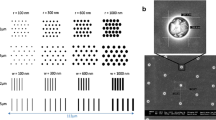Abstract
Nanofluidic electrochemical devices confine the volume of chemical reactions to femtoliters. When employed for light generation by electrochemiluminescence (ECL), nanofluidic confinement yields enhanced intensity and robust luminescence. Here, we investigate different ECL pathways, namely coreactant and annihilation ECL in a single nanochannel and compare light emission profiles. By high-resolution imaging of electrode areas, we show that different reaction schemes produce very different emission profiles in the unique confined geometry of a nanochannel. The confrontation of experimental results with finite element simulation gives further insight into the exact reaction ECL pathways. We find that emission strongly depends on depletion, geometric exclusion, and recycling of reactants in the nanofluidic device.







Similar content being viewed by others
References
Bard AJ. Electrogenerated chemiluminescence. New-York: M. Dekker; 2004.
Sojic N, editor. Analytical electrogenerated chemiluminescence: from fundamentals to bioassays. Detection Science: Royal Society of Chemistry (RSC) Publishing; 2020.
Forster RJ, Bertoncello P, Keyes TE. Electrogenerated chemiluminescence. Annual Rev Anal Chem. 2009;2(1):359–85. https://doi.org/10.1146/annurev-anchem-060908-155305.
Liu Z, Qi W, Xu G. Recent advances in electrochemiluminescence. Chem Soc Rev. 2015;44(10):3117–42. https://doi.org/10.1039/c5cs00086f.
Richter MM. Electrochemiluminescence (ECL). Chem Rev. 2004;104(6):3003–36. https://doi.org/10.1021/cr020373d.
Miao W. Electrogenerated chemiluminescence and its biorelated applications. Chem Rev. 2008;108(7):2506–53. https://doi.org/10.1021/cr068083a.
Sojic N, Arbault S, Bouffier L, Kuhn A. Applications of electrogenerated chemiluminescence in analytical chemistry. In: Miomandre F, Audebert P, editors. Luminescence in electrochemistry: applications in analytical chemistry. Cham: Physics and Biology. Springer International Publishing; 2017. p. 257–91. https://doi.org/10.1007/978-3-319-49137-0_8.
Valenti G, Rampazzo E, Kesarkar S, Genovese D, Fiorani A, Zanut A, et al. Electrogenerated chemiluminescence from metal complexes-based nanoparticles for highly sensitive sensors applications. Coord Chem Rev. 2018;367:65–81. https://doi.org/10.1016/j.ccr.2018.04.011.
Zhai Y, Zhu Z, Zhou S, Zhu C, Dong S. Recent advances in spectroelectrochemistry. Nanoscale. 2018;10(7):3089–111. https://doi.org/10.1039/c7nr07803j.
Garoz-Ruiz J, Perales-Rondon JV, Heras A, Colina A. Spectroelectrochemical sensing: current trends and challenges. Electroanalysis. 2019;31(7):1254–78. https://doi.org/10.1002/elan.201900075.
Lozeman JJA, Führer P, Olthuis W, Odijk M. Spectroelectrochemistry, the future of visualizing electrode processes by hyphenating electrochemistry with spectroscopic techniques. Analyst. 2020. https://doi.org/10.1039/c9an02105a.
Kapturkiewicz A. Electrochemical generation of excited intramolecular charge-transfer states. ChemElectroChem. 2017;4(7):1604–38. https://doi.org/10.1002/celc.201600865.
Amatore C, Pebay C, Servant L, Sojic N, Szunerits S, Thouin L. Mapping electrochemiluminescence as generated at double-band microelectrodes by confocal microscopy under steady state. ChemPhysChem. 2006;7:1322–7.
Doeven EH, Zammit EM, Barbante GJ, Hogan CF, Barnett NW, Francis PS. Selective excitation of concomitant electrochemiluminophores: tuning emission color by electrode potential. Angew Chem Int Ed. 2012;51(18):4354–7. https://doi.org/10.1002/anie.201200814.
Liu X, Shi L, Niu W, Li H, Xu G. Environmentally friendly and highly sensitive ruthenium(II) Tris(2,2′-bipyridyl) electrochemiluminescent system using 2-(dibutylamino)ethanol as co-reactant. Angew Chem Int Ed. 2007;46(3):421–4. https://doi.org/10.1002/anie.200603491.
Miao W, Choi J-P, Bard AJ. Electrogenerated chemiluminescence 69: the Tris(2,2′-bipyridine)ruthenium(II), (Ru(bpy)32+)/Tri-n-propylamine (TPrA) system eevisited a new route involving TPrA•+ cation radicals. J Am Chem Soc. 2002;124(48):14478–85. https://doi.org/10.1021/ja027532v.
Sentic M, Milutinovic M, Kanoufi F, Manojlovic D, Arbault S, Sojic N. Mapping electrogenerated chemiluminescence reactivity in space: mechanistic insight into model systems used in immunoassays. Chem Sci. 2014;5(6):2568–72. https://doi.org/10.1039/c4sc00312h.
Rinklin P, Mayer D, Wolfrum B. Electrochemical nanocavity devices. In: Schöning MJ, Poghossian A, editors. Label-free biosensing: advanced materials. Cham: Devices and Applications. Springer International Publishing; 2018. p. 199–214. https://doi.org/10.1007/5346_2017_8.
White HS, McKelvey K. Redox cycling in nanogap electrochemical cells. Curr Op Electrochem. 2018;7:48–53. https://doi.org/10.1016/j.coelec.2017.10.021.
Al-Kutubi H, Voci S, Rassaei L, Sojic N, Mathwig K. Enhanced annihilation electrochemiluminescence by nanofluidic confinement. Chem Sci. 2018;9(48):8946–50. https://doi.org/10.1039/c8sc03209b.
Cui J, Mathwig K, Mampallil D, Lemay SG. Potential-controlled adsorption, separation, and detection of redox species in nanofluidic devices. Anal Chem. 2018;90(12):7127–30. https://doi.org/10.1021/acs.analchem.8b01719.
Kang S, Nieuwenhuis AF, Mathwig K, Mampallil D, Kostiuchenko ZA, Lemay SG. Single-molecule electrochemistry in nanochannels: probing the time of first passage. Farad Discuss. 2016;193(0):41–50. https://doi.org/10.1039/c6fd00075d.
Krause KJ, Mathwig K, Wolfrum B, Lemay SG. Brownian motion in electrochemical nanodevices. Eur Phys J SpecTop. 2014;223(14):3165–78. https://doi.org/10.1140/epjst/e2014-02325-5.
Mathwig K, Lemay SG. Pushing the limits of electrical detection of ultralow flows in nanofluidic channels. Micromachines. 2013;4(2):138–48.
Valenti G, Fiorani A, Li H, Sojic N, Paolucci F. Essential role of electrode materials in electrochemiluminescence applications. ChemElectroChem. 2016;3(12):1990–7. https://doi.org/10.1002/celc.201600602.
Mathwig K, Sojic N. Towards determining kinetics of annihilation electrogenerated chemiluminescence by concentration-dependent luminescent intensity. J Anal Test. 2019;3(2):160–5. https://doi.org/10.1007/s41664-019-00094-z.
Qiu R, Zhang X, Luo H, Shao Y. Mass spectrometric snapshots for electrochemical reactions. Chem Sci. 2016;7(11):6684–8. https://doi.org/10.1039/c6sc01978a.
Qin X, Gu C, Wang M, Dong Y, Nie X, Li M, et al. Triethanolamine-modified gold nanoparticles synthesized by a one-pot method and their application in electrochemiluminescent immunoassy. Anal Chem. 2018;90(4):2826–32. https://doi.org/10.1021/acs.analchem.7b04952.
Theakstone AG, Doeven EH, Conlan XA, Dennany L, Francis PS. ‘Cathodic’ electrochemiluminescence of [Ru(bpy)3]2+ and tri-n-propylamine confirmed as emission at the counter electrode. Chem Commun. 2019;55(49):7081–4. https://doi.org/10.1039/c9cc03201k.
Valenti G, Scarabino S, Goudeau B, Lesch A, Jović M, Villani E, et al. Single cell electrochemiluminescence imaging: from the proof-of-concept to disposable device-based analysis. J Am Chem Soc. 2017;139(46):16830–7. https://doi.org/10.1021/jacs.7b09260.
Author information
Authors and Affiliations
Corresponding authors
Ethics declarations
This article does not contain any studies with human or animal subjects performed by any of the contributing authors.
Conflict of interest
The authors declare that they have no conflict of interest.
Additional information
Publisher’s note
Springer Nature remains neutral with regard to jurisdictional claims in published maps and institutional affiliations.
Electronic supplementary material
ESM 1
(DOCX 1385 kb)
Rights and permissions
About this article
Cite this article
Voci, S., Al-Kutubi, H., Rassaei, L. et al. Electrochemiluminescence reaction pathways in nanofluidic devices. Anal Bioanal Chem 412, 4067–4075 (2020). https://doi.org/10.1007/s00216-020-02630-8
Received:
Revised:
Accepted:
Published:
Issue Date:
DOI: https://doi.org/10.1007/s00216-020-02630-8




